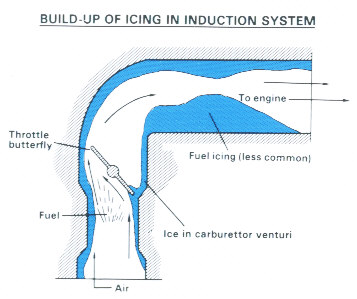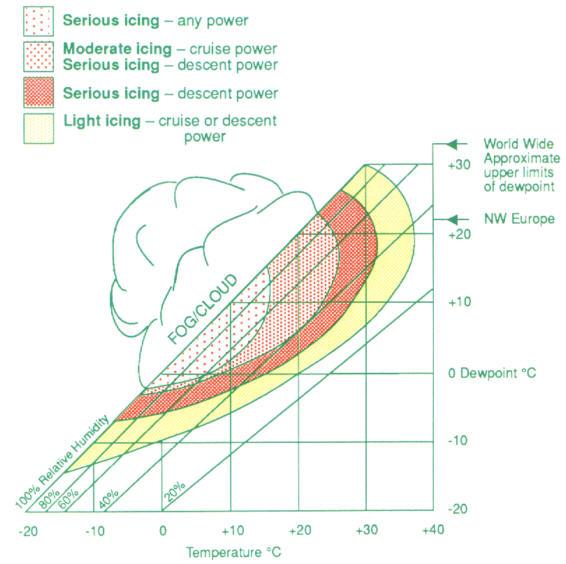The Lycoming O-360-A4M that is fitted to all our tug aircraft is liable to engine icing in certain conditions. In extreme circumstances the engine may stop altogether or may just cause rough running. Either way it is important to be alert to the ambient conditions that produce engine icing potential and be methodical in protecting your engine against it's formation.

Types of Icing
There are three types of icing that can affect our engines.
a. Carburettor Icing
The most common, earliest to show, and the most serious, is carb icing. This is caused by the sudden temperature drop due to fuel vaporisation and pressure reduction at the carburettor venturi. The temperature drop may be as much as 30ºC and results in atmospheric moisture forming ice which gradually blocks the venturi. This slowly strangles the engine upsetting the fuel/air ratio causing a progressive, smooth loss of power. The conventional float type carburettor, as fitted on our engines, being more prone to icing than pressure jet types.
b. Fuel Icing
Less common, is fuel icing, which is the result of water, held in suspension in the fuel, precipitating out and freezing in the induction piping.
c. Impact Icing
Ice that builds up on air intakes and filters by operating in snow, sleet, sub-zero cloud and rain is known as Impact Icing. It will obviously adversely affect the performance of both your engine and aircraft.
Conditions conducive to Carb Icing
The diagram below shows the Temperature/Dew Point combinations that can lead to carb icing. It is worth noting that even on a summer day with a temperature of 25 ºC given high humidity, carb icing is possible.

Clues to high humidity include the following;
- Operating close to cloud base.
- Operating in precipitation.
- If the ground is wet from dew or recent rain.
- Operating in reduced visibility.
- Operating in clear air where fog or low cloud has just dispersed
Cold days where the visibility is poor, where the cloud base is low or a clear day with heavy dew or frost should be regarded as days when carb icing is most likely.
Recognition of Carb Icing
A slight drop in RPM is the mostly likely indication of the onset of carb icing, although rough running is another.
In cruise or descent this will happen slowly and without any throttle movement.
On take-off, if full power is not achieved. It is obviously important to know the normal maximum RPM for each of our engines in order to detect this. Note:- Leaving the carb heat on would give a similar indication.
Precautions to take
- Operate carb heat immediately after a cold engine start.
- Operate carb heat prior to take-off.
- Check that max rpm is attained during take-off.
- Operate carb heat in descent, if the flight has gone up to or beyond cloudbase.
- Operate carb heat during or after prolonged ground running.
- Operate carb heat during the approach checks as normal.
Remember normal carb heat operation is to select for 10 to 20 seconds and then return to cold.
Feedback (see below)
Please feed back any occurrences of icing during our operation.
Robin May
Chief Tug Pilot
November 2001
Pete Claiden comments;
...in my experience YM is the most prone to icing, particularly after
starting from cold in the morning and then taxying out. Over the
channel last year on my way to Spain, I had serious carb icing at
3000 ft, 50 miles from land! It was a warm but very muggy day, ie
high humidity; the engine began to run slightly roughly, lost 2-300
rpm on heat selection, recovered and then gained some 300 rpm when
cold air re-selected. Subsequently I had to pull carb heat every few
minutes to avoid loosing power.
XI is not quite as bad as YM, and the Cubs seem to be best...
Additional info for CA
When CA has icing, the MAP will slowly drop as the aircraft descends (instead of slowly rising). Operating Carb Heat whilst the engine is governing will cause a slow increase in MAP as the ice melts. Normal clues and operation apply when outside of the governed range, ie; when power reduced for the approach.